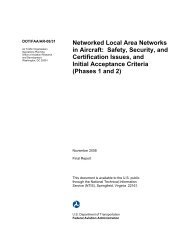Published Report (DOT/FAA/CT-94-36)
Published Report (DOT/FAA/CT-94-36)
Published Report (DOT/FAA/CT-94-36)
You also want an ePaper? Increase the reach of your titles
YUMPU automatically turns print PDFs into web optimized ePapers that Google loves.
Technical Center. Indicated air speeds of 180 knots (kn) were<br />
assigned for turbojets, 150 kn for turboprops, and 120 kn for<br />
twin engine piston aircraft. Preliminary data indicated that<br />
during the simulation, a total of 746 blunders were initiated,<br />
376 for the triple approach configuration and 370 for the<br />
quadruple approach configuration. Approximately 74 percent of<br />
all blundering aircraft did not respond to air traffic control<br />
(ATC) commands.<br />
Preliminary data analyses indicated that the test criterion<br />
violations (TCV's) (aircraft separated by less than or equal to<br />
500 feet) exceeded the test criterion rate of 2 percent set to<br />
evaluate the operation. However, the number of NBO's and NTZ<br />
entries was acceptable based on the criteria set by the TWG.<br />
Qualitative data from the controller questionnaires indicated<br />
that when the ARTS IIIA display was used, it was "very difficultvv<br />
to perform the monitor controller task. The controllers also<br />
disagreed with the statement that Ittriple independent IFR<br />
approaches to runways spaced 5280 and 7600 ft apart can be safely<br />
conducted as simulated.11<br />
After reviewing the preliminary data, controller opinions, and<br />
technical observer comments, it was decided that an additional<br />
high density altitude simulation should be conducted using the<br />
Full Digital ARTS I11 Display System (FDADS) and data specific to<br />
DIA. To make this simulation site specific to DIA, additional<br />
information about air traffic and airport operations was<br />
requested from representatives from the Northwest Mountain Region<br />
and the Air Traffic Division of the <strong>FAA</strong>.<br />
1.1.1.2 Simulation Usina the FDADS.<br />
A second simulation was conducted to evaluate the performance of<br />
controllers monitoring triple simultaneous approaches to parallel<br />
runways using the FDADS. In this simulation, assigned aircraft<br />
speeds were kept at 170 kn for all turbojet and turboprop<br />
aircraft. Additionally, twin-engine piston aircraft were<br />
assigned a 150 kn IAS. The three-week simulation began on<br />
November 16, 1992, but was terminated on November 18, 1992,<br />
because preliminary data indicated that the operation would not<br />
meet performance goals set by the TWG.<br />
Preliminary data for aircraft separation, NBO's, and NTZ entries<br />
were reviewed daily. At the end of the second day of simulation,<br />
1169 aircraft were handled, 87 blunders were initiated into<br />
flight simulators, and 5 TCV's were reported. Although the data<br />
for NTZ entries and NBO's appeared to be within the goals set by<br />
the TWG, this sample of data (5 TCV's out of 87 blunders = 5.7<br />
percent TCV rate) exceeded the blunder resolution performance<br />
goal set by the TWG. Additionally, TWG members, simulation<br />
participants, and observers from <strong>FAA</strong> Headquarters and the<br />
4

















